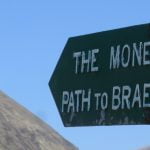Remains of a Pictish home.
Careful scrutiny of the very tussocky ground on this site still reveals the outline of a Pictish Longhouse called a Pitcarmick House.
Archaeologists surveying North East Perthshire in the 1980’s identified a series of buildings previously unseen anywhere else in Scotland. Named ‘Pitcarmick’ buildings after the estate in Strathardle where they were first discovered, these unusual buildings appear as low earth banks, and have an elongated rectangular form between 5m and 30m in length with slightly curved side walls and rounded gable ends.
Radiocarbon dating show that Pitcarmick-type longhouses were built in the Early Historic or Pictish period c600-900AD.
Excavated examples from the groups at Pitcarmick in Strathardle and Lair in Glenshee have revealed that the buildings functioned as byre-houses and were primarily constructed of turf and earth, sometimes with a stone foundation.
In these byre-houses, people would have lived in one end whilst cattle were over-wintered in the other. A gently sloping floor allowed animal waste to flow away from the living quarters whilst a hearth provided heat and light. Radiocarbon dating has shown that the Pitcarmick-type longhouses were built in the Early Historic, or Pictish, period (c.600-900 AD).



